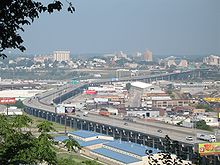Lewis and Clark Viaduct
| Lewis and Clark Viaduct | |
|---|---|

Intercity and Lewis and Clark Viaducts. Intercity Viaduct is left, Lewis and Clark Viaduct is right.
|
|
| Coordinates | 39°06′48″N 94°36′54″W / 39.1133°N 94.6149°WCoordinates: 39°06′48″N 94°36′54″W / 39.1133°N 94.6149°W |
| Carries | 7 lanes of |
| Crosses | Kansas River |
| Locale | Kansas City, Kansas–Kansas City, Missouri |
| Official name | Lewis and Clark Viaduct |
| Maintained by | KDOT and MoDOT |
| Characteristics | |
| Design | Deck truss |
| Width | 52 ft (15.8 m) |
| Longest span | 3,777 ft (1,151.1 m) |
| Clearance above | 29 ft (8.8 m) |
| History | |
| Opened | 1907 eastbound, 1962 westbound |
| Statistics | |
| Daily traffic | 23,500 |
The Intercity Viaduct (officially the Lewis and Clark Viaduct since 1969) is an automobile and pedestrian crossing of the Kansas River in the United States. Designed by Waddell and Hedrick, this four lane, two level deck truss bridge was built in 1907. It rises above the West Bottoms, and several sets of railroad tracks. It was the first roadway bridge to connect Kansas City, Missouri, with Kansas City, Kansas, non-stop all the way across. It is about 1.5 miles (2.4 km) long and carries eastbound traffic for Interstate 70 (I-70)/U.S. Route 24 (US 24)/US 40/US 169, while its sister bridge, the Lewis and Clark Viaduct, built in 1962, carries westbound traffic.
The eastbound lanes were built as the Intercity Viaduct, carrying both east and west lanes, but renamed the Lewis and Clark Viaduct on January 25, 1969, taking the name of its sister bridge that would now carry the westbound lanes, built in 1962 to the north.
Designed by the engineering firm Waddell and Hedrick in 1903, the viaduct followed a flood that same year that wiped out all but one of the 17 bridges that spanned the Kaw River. Ground broke to mark the building of the bridge in 1905.
...
Wikipedia
